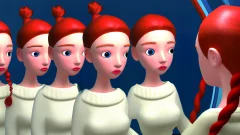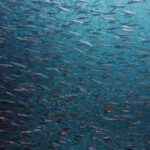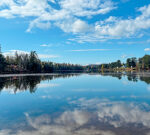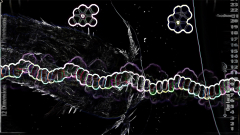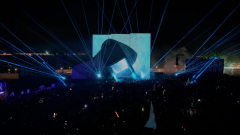In this interview, originally published in the A/W 2022 issue of Fact’s print edition, Holly Herndon and Mat Dryhurst discuss AI art and digital sovereignty.
Holly Herndon and Mat Dryhurst’s work, both as solo artists and collaborators, is often concerned with the effects of disruptive technologies. Herndon’s 2015 album, Platform, drew attention to issues like technological surveillance, while PROTO, released in 2019, was created with the help of an Al model they developed and trained through live ceremonies. Saga, a self-hosting framework that Dryhurst developed in 2015 as a decentralised way to host content, envisioned a way for artists to meaningfully own and control their works online and circumvent centralised platforms.
2021’s Holly+ is an experiment in digital sovereignty, combining a DAO (decentralised autonomous organisation) with a voice tool that allows anyone to make music using Herndon’s voice.
Herndon and Dryhurst’s work has been far ahead of the curve – so much so that it now feels prophetic. Data privacy is an issue of wide concern, creatives are starting to question what machine learning technology might mean for their livelihoods, and the smart contract technology behind NFTs now offer artists a way to meaningfully own and sell their work. Their outlook is cautionary but inherently optimistic about the possibilities these new technologies can bring to artists, and for the past few years they’ve guided people through this changing world via their Interdependence podcast.
Herndon and Dryhurst believe the changes that Al will bring will radically transform the creative landscape, allowing anyone to easily generate art and music from Al tools trained on the work or likeness of existing creators. This process, which they have dubbed ‘spawning’, is explored in Herndon’s NFT collection CLASSIFIED, a series of self-portraits generated in distinct artistic styles that show what Open Al’s CLIP language/image pairing network understands ‘Holly Herndon’ to be.
In this interview, originally published in Fact’s A/W 2022 print issue – before consumer AI tools such as ChatGPT and Midjourney hit the mainstream consciousness – Herndon and Dryhurst talk in depth with Fact contributing editor Scott Wilson about their experimentation in these new digital frontiers, and how they think they may develop in the future.
SCOTT WILSON: One thing I’ve found fascinating about your practice over the past few years is how you’ve leaned into the visual realm through the machine learning art and NFTs – specifically the CLASSIFIED collection, which is a series of Al portraits ‘painted’ in a variety of styles. Is this just for experimentation or is this a core part of your joint practice now?
HOLLY HERNDON: Mat and I have been working in a conceptual space for years now. Our main output was albums and live performances, but that didn’t cover the full spectrum of what we were interested in researching and navigating. There’s a structural side, which is why we’re building software, and then there’s a visual side. The core practice hasn’t changed that much, but we’ve broadened our output and that’s really exciting for me right now. I still love making albums but I like the idea of being able to use different mediums to express ideas in different ways. Whereas Holly+ hits home in one particular way, especially when somebody can sing through my voice and sound exactly like me, that illustrates one side of the same kind of theme that the CLASSIFIED portraits explore in the visual realm.
MAT DRYHURST: The ability to value and publish other works as part of the greater practice with some of the new habits that we’re forming, such as NFT sales, compliments what we’re doing. Part of the reason we do the podcast is that it’s part of the practice. We’re making public what we’re talking about and the people we’re meeting and collaborating with. We’ve been contributing to many areas for a while. it’s maybe only just recently that people are seeing that.
SW: The past few years have seen a number of artists experiment with web3 and NFTs, perhaps due to the economic and social effects of being locked down during the pandemic. Do you think artists and fans are becoming more open to the idea that decentralised technology can create more equitable models for creators?
HH: I hope so. I think people started to recognise internet life as real life because we were all stuck in our homes. I think what got hammered home is that there isn’t necessarily this huge divide between your digital self and your IRL self. Hopefully that helps people realise that they need to think about things like data sovereignty and these issues that Mat and I have been looking at since the Platform days.
MD: It was quite clear around 2014/2015 that the centralised internet just wasn’t compatible with what we were doing, or it wasn’t all that compelling to us. At that time some people in the arts decided to lean into Instagram and start taking selfies of themselves and playing the feed, and in our corner we thought it would be way more cool to start diving into what an alternative internet would look like.
I think in some ways Covid-19 really exposed a lot of the impoverished nature of online life. All of a sudden DJs couldn’t get on cheap flights to pay their rent. And so it really put into stark relief just how little artists own when there’s not a sales economy outside of Bandcamp Fridays. It made these politics feel all that more real.
Since 2017 or so there has been a slow maturation of the fundamental tools that would make any of this stuff actually practicable and real to people. I share Holly’s optimism, but how it pans out in terms of people pushing for more equitable arrangements remains to be seen. But the idea of decentralising – not just infrastructure but not having everyone use the internet in the same way to reach the same objective – that just makes a ton of sense.
HH: When we moved to the Bay Area so that I could go to Mills College to study experimental electronic music, neither of us were super involved with technology. Then we learned that there is technical development which is subcultural. We encountered a lot of really strange people building technology that suited their own particular worldviews and that of their small communities. I think that’s what attracted us and that’s maybe what Mat is alluding to – which we see happening and thriving in this web3 space – that people are being encouraged to take back some agency over how technology is influencing their lives.
SW: Your recent project Holly+ is an experiment in decentralisation, allowing creators to use a voice model to create and sell works made from your voice as NFTs. It’s governed by a DAO and there’s a profit split for minted works, which is 50% to the artist, 40% to a treasury for future projects and 10% to you. How does this all work?
HH: For season one, people submitted their tracks and we, as a DAO, actually voted to accept all submissions this first time. We put them up for auction with a custom front-end NFT auction site that we worked on with Zora. As Mat mentioned, a lot of the tools aren’t plug and play yet. We worked with 0xSplits on the royalty mechanism because that was a really important part, to see if we could not only split the profits in this way that they would go back to fund the project to develop further iterations of the instrument, but also for future sales on the secondary market for that split to continue. It’s a really interesting test case.
SW: How does the DAO function and how much decision making does it do on vour behalf?
MD: At the moment it’s pretty informal. There’s a bunch of supporters and friends who have contributed to the project who are in there, and the idea is that things can be put up for a really informal vote so we can compare notes and then have casual conversations, because there’s a lot of over-architecting that could happen. But over time, fully decentralised governance may become more important.
HH: The work and the precedents that we’re putting in place over the next several years with this DAO will eventually lay the foundation for how our IP will be dealt with posthumously. I know that sounds really morbid, but there’s often decisions that are made that don’t feel in line with what the artists would’ve chosen in their lifetime, so it’s a way to be able to set precedent for how we want things to be dealt with on a longer time horizon.
SW: Are you optimistic on the potential role DAOs can play in the creative space?
HH: I’m personally very optimistic about the notion of online collaboration between people. That’s essentially what a DAO is. Whether or not we’re gonna call it a DAO in ten years, I don’t know, but I think people are building all kinds of tools to make it easier for people who aren’t living in the same place to collaborate with each other online, and I think a lot of people are finding really great meaning and productivity through that. There’s projects like Metalabel and Songcamp who are thinking about the future of collaboration, and which has probably been forever changed through Covid-19. How do you keep the energy going in a distributed online community? That’s an ongoing question that needs to be answered.
MD: As Holly said, these kinds of tools for coordinating with both people you know and strangers in a more trusting environment where you have shared access to a treasury is fundamental to crypto. A trusting environment where strangers can come together, pool resources and potentially vote and debate where those resources are allocated is a habit that is absolutely here to stay. We’ll see how that pans out, but I think that interaction is a really cool thing that makes a lot of sense.
SW: Your work together has been concerned with the possibilities and existential questions around artificial intelligence for almost a decade, but public awareness of this technology has spiked recently due to projects like DALL•E. How does DALL•E work and what makes it so significant?
MD: Around 2016 it became possible to do a lot of this stuff yourself on a home GPU, so the field has developed quite rapidly. What’s unique about DALL•E is that OpenAl has developed a couple of techniques, one of which is called guided diffusion, which basically lets you generate media from nothing. When you pair a diffusion system or other image generator systems with something they created called CLIP, which labels images in accordance with words, you’re able to type words and generate images that are the sum product of those words. The consensus is that this is called prompting.
We’ve been working with machine learning stuff since about 2016 so none of this was surprising to us, but kind of like the NFT thing, what is surprising is that it’s the first time that people, on a really large scale, are getting to interact with this kind of new category of machine learning or art generation tools. What’s cool is that it’s people’s first glimpse as to what the future of creating art is going to look like.
This is not me saying that I think the future of art is going to be people typing sentences into a browser. But the ability to generate and customise media based on what you would like to see, built on a foundation of training information about artists and scenarios is what vou would call a new substrate for how media’s going to work. Without being too hyperbolic about it, I believe this is bigger than the home computer was for art creation. I think people are underestimating how big a deal this is going to be, and quite how fast it’s getting good.
SW: The images in the CLASSIFIED collection are uncannily accurate, especially the ‘Holly memes’. Were they created with public data or old you have to feed the model your own images to create this output?
HH: I’m a ‘public figure’ so it’s just scraping images of myself that are freely available on the internet. CLIP has this idea of me, a reduced stereotype of my image, which is ‘white lady with orange braid and blue eyes’. So you can take anything like a house and make it Holly Herndon. Those are the kinds of attributes that it will give to whatever object or idea you’re combining with my name.
You can of course create your own super high-fidelity material. If we wanted something that was realistically aligned with my actual detailed features, then you could crea

